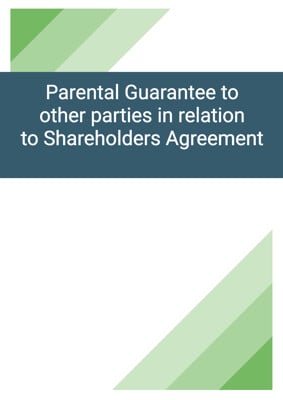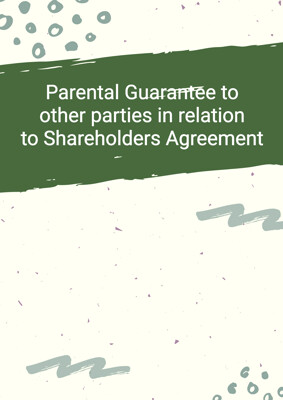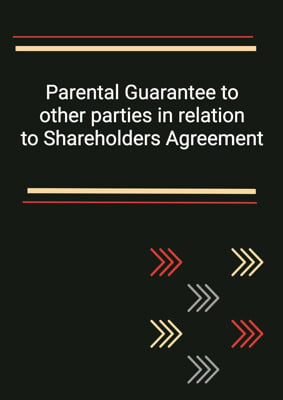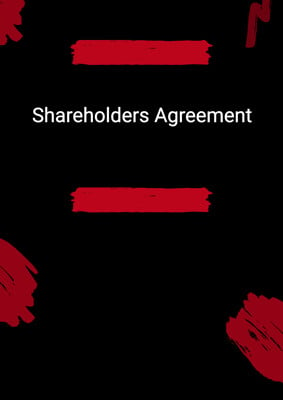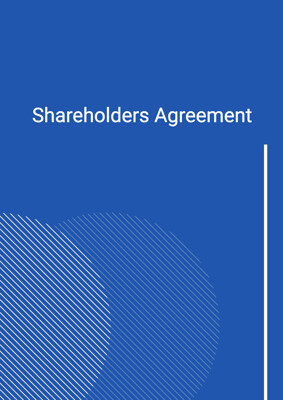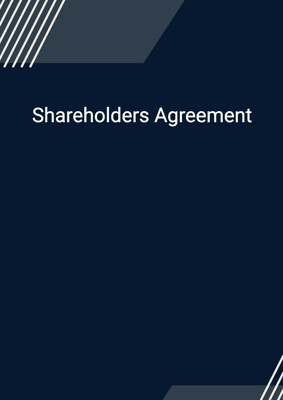How to Tailor the Document for Your Need?
01
Create Document
Fill in the details of the parties. You can click the "Fill with Member’s Information" button to complete it with information saved to your account.
02
Fill Information
Please fill in any additional information by following the step-by-step guide on the left hand side of the preview document and click the "Next" button.
03
Get Document
When you are done, click the "Get Document" button and you can download the document in Word or PDF format.
04
Review Document
Please get all parties to review the document carefully and make any final modifications to ensure that the details are correct before signing the document.
Document Preview
Document Description
This document is a shareholders agreement that is entered into by three parties (referred to as party 1, party 2, and party 3) who have agreed to form a new jointly-owned company. The purpose of this agreement is to govern the relations between the parties as shareholders in the company. The document begins with an interpretation section that defines various terms used throughout the agreement. It then proceeds to outline the establishment of the company, including the incorporation process and the completion of necessary events and transactions. The agreement also covers the capital structure of the company, further finance options, and the dividend policy. The document addresses the composition and functioning of the board of directors, including the appointment and removal of directors. It also includes a section on reserved shareholder matters, which require the prior approval of the parties. The agreement sets out restrictions on the parties, including a prohibition on engaging in competing businesses. It specifies the term of the agreement and the conditions for termination. Confidentiality obligations are outlined, and the agreement emphasizes the parties' commitment to mutual consultation and goodwill. The document prohibits the assignment of rights and obligations under the agreement without proper consent. It contains a clause on conditions precedent, if applicable, and provides for the amendment of the agreement. The agreement states that it constitutes the entire agreement between the parties and includes a provision for dispute resolution. Finally, the document addresses the service of notices and provides for the language and jurisdiction of the agreement.
How to use this document?
To use this document, follow these steps:
1. Incorporation: As soon as possible after the date of this agreement, the parties should cause the company to be incorporated in the specified country as a company limited by shares. The memorandum and articles of the company should be in the agreed form attached to the agreement.
2. Completion: Completion of the establishment of the company should take place as specified in the agreement. This includes the subscription for shares by each party, the allotment and issuance of shares, and the execution of ancillary agreements.
3. Capital and Finance: The company's share capital should be as specified in the agreement. Any increase in share capital should be agreed upon by the parties. If further finance is required, the company should first approach its own bankers. If finance cannot be obtained, the parties may provide finance in equal proportions.
4. Directors and Management: The board of directors should be constituted by directors appointed by each party. Each party has the right to appoint and remove directors. The quorum for board meetings should be at least one director appointed by each party. Each director is entitled to one vote.
5. Reserved Shareholder Matters: Certain matters require the prior approval of the parties, including issues of shares, sale of the company, alterations to the memorandum and articles, borrowing by the company, and approval of the annual budget and operating plan.
6. Transfer of Shares: If a party desires to sell or dispose of any shares, it must give a transfer notice to the other party. The continuing party has the right to purchase the shares at the proposed price. If no agreement is reached, the fair price will be determined by the auditors. Restrictions on dealing with shares and undertakings by transferees should be observed.
7. Confidentiality: Both parties must keep confidential any information acquired in relation to the company or the other party's business. Exceptions to this obligation are specified in the agreement.
8. Restrictions on the Parties: Neither party or any member of its group should engage in any competing business during the term of the agreement.
9. Term and Termination: The agreement has a minimum term and will continue from year to year unless terminated by either party. Termination can be initiated by giving prior notice. Termination may also occur in the event of default, insolvency, or a change in control. In such cases, the terminating party may have the right to purchase the shares of the affected party.
10. Supremacy of this Agreement: The parties should ensure that this agreement is duly performed and that the provisions of the memorandum and articles are not infringed. In case of any conflict, this agreement prevails.
11. Costs: The costs of incorporating the company are borne by the company. Each party is responsible for its own costs in preparing and executing the agreement.
12. No Partnership or Agency: The agreement does not create a partnership or agency relationship between the parties.
13. Entire Agreement: This agreement, along with any other agreements entered into on completion, constitutes the entire agreement between the parties. It supersedes any previous heads of agreement.
14. Mutual Consultation and Goodwill: The parties are committed to promoting the best interests of the company and consulting on matters affecting its development. They should act in good faith towards each other.
15. Assignment: The agreement cannot be assigned or transferred without proper consent, except in the case of transferring shares in accordance with the agreement.
16. Conditions Precedent: If applicable, completion of the agreement is subject to certain conditions precedent. The parties should ensure that these conditions are fulfilled or waived.
17. Amendment: Any variation of the agreement must be in writing and signed by the parties. Variations do not constitute a general waiver and do not affect accrued rights and obligations.
18. No Rights of Third Parties: Only the parties to the agreement have the right to enforce its terms.
19. Dispute Resolution: Any disputes arising from the agreement should be resolved in accordance with the specified jurisdiction clause.
20. Notices and Service: Notices under the agreement should be in writing and served by email, hand delivery, or post. The agreement provides specific instructions for serving notices.
Please note that this guidance is a summary and should be used in conjunction with the actual agreement for full understanding and implementation.
Not the right document?
Don’t worry, we have thousands of documents for you to choose from:

